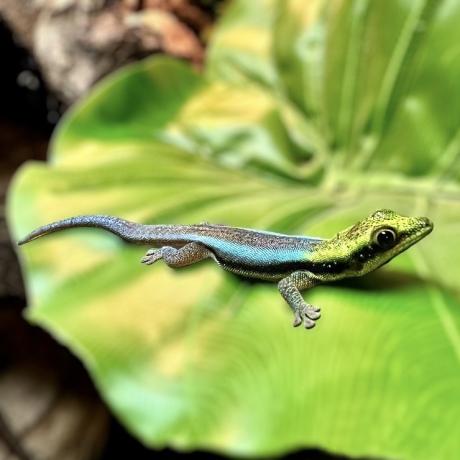

This vibrantly coloured diurnal Gecko belongs to the smallest subfamily of day geckos. They are endemic to Northwest Madagascar inhabiting coastal forests.
Neon Day Geckos are, as their name suggests - vibrantly coloured diurnal geckos. They are a small, flat bodied species, reaching a total length of around 9cm; and are most active during daylight hours. Their heads are bright yellow, often patterned with darker speckling, displaying a dark spot behind their lidless eyes. Following down from this is a dark stripe continuing down the length of the body. The main body colouration is a bright turquoise blue, fading from the neck downwards to a yellow/brown and back to a pale blue/lilac down the length of the tail. Males display the characteristic hemipenal bulges seen in many gecko species and prominent femoral pores. Males generally also display more of an orange colouration around the vent once mature. The Neon Day Gecko has ‘sticky feet’ covered in microscopic hairs called setae - meaning that it is able to climb almost any surface.
The Neon Day Gecko was originally discovered in 1990 and is limited to a very small coastal area in North West Madagascar. It is thought to be threatened in the wild as they are found living in large numbers in only a handful of localised bamboo thickets - bamboo is cultivated in Madagascar as a building material, and there is also the ongoing devastation caused by deforestation. The bamboo plays a vital role in their lives; it provides protection from predators (they will flatten their bodies to hide in the cracks), it collects water, and has plenty of places in which they can deposit their eggs.
As these geckos are arboreal (tree dwelling) the glass terrarium should have plenty of usable height. We advise a minimum of 45 x 45 x 45cm (18in cube) though it is better to offer a 45 x 45 x 60cm (18 x 18 x 24in) especially if housing multiple geckos. Sexed groups can cohabit, ensuring there is only one male present per tank to avoid any rivalry over the females.
The Neon Day Gecko requires ambient temperatures of around 22-26°C with a basking spot of 28-30°C during the daytime when they are most active. A night time temperature drop of between 5-10°C is recommended, to simulate the temperature drop which happens in the wild when the sun sets. The basking bulb must be controlled by using a dimming thermostat, ensuring your geckos are maintained at the optimum temperature.
It is vital to provide these geckos with access to UVB lighting that sits within the parameters of Ferguson Zone 2, this helps them to produce vitamin D3 which is essential in the absorption of Calcium - keeping bones healthy and strong. This should be on for 12 hours during the day and turned off at night.
The forests of Madagascar are notoriously warm and humid, and these geckos are found towards the coast. Their natural humidity levels will fluctuate and can rise and fall between 60-80%. We recommend misting the decor, foliage and substrate both morning and evening. A shallow water dish can be added, but the gecko will tend to drink droplets of water from the foliage to stay hydrated.
For terrarium decor, the use of bamboo mimics their natural habitat beautifully. Adding in vertical poles with foliage provides natural enrichment and offers the geckos plenty of vertical climbing space. Cork branches and vines also work well, adding to the natural look of any rainforest habitat. Artificial plants are ideal for adding plenty of coverage while keeping the setup fairly simple to maintain. It is worth noting however, that the Neon Day Geckos also do extremely well in live planted, bio-active tanks. Use a soil based substrate to cover the floor; adding a layer of leaf litter and moss on top of this can help to retain moisture.
Juveniles and adults can be fed on a high quality meal replacement powder diet, though by providing the geckos with feeder insects, it offers enrichment by way of encouraging natural hunting and foraging behaviours.
On all live feeds, it is important to use a good quality supplement powder to provide an essential calcium and vitamin boost to your Neon Day Gecko. The easiest method of application is to use a spare live food tub to dust the insects lightly in supplement. We advise dusting your insects on every feed, alternating between calcium and vitamin powders according to manufacturers recommendations.